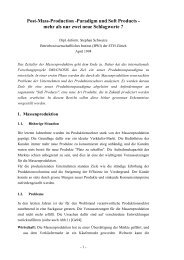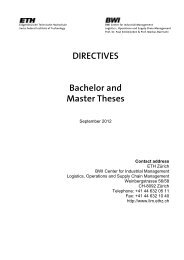The China Venture
The China Venture
The China Venture
Create successful ePaper yourself
Turn your PDF publications into a flip-book with our unique Google optimized e-Paper software.
2. <strong>The</strong> Chinese Business Environment<br />
<strong>The</strong> economic transformation of modern <strong>China</strong> from a Soviet-style, centrally planned<br />
economy to one which is increasingly market-oriented and open to foreign business<br />
investments and operations began in 1978. <strong>The</strong> story of <strong>China</strong>’s economic reform based on<br />
the setting up and rapid growth of a market economy which is becoming increasingly<br />
important, and in parallel to an existing and dominant command economy which shrinks in<br />
tandem with the growing dominance of the market economy, provides certainly an interesting<br />
lesson in economic transformation change. Matthias Weibel wrote about the <strong>China</strong> Reform<br />
story ...<br />
2.1 <strong>The</strong> <strong>China</strong> Reform story (by Matthias Weibel)<br />
Under the guidance of Deng Xiaoping the economic reforms started with the “Four<br />
Modernisations“ involving agriculture, industry, science and technology, and national<br />
defence. In agriculture the authorities replaced the old collectivisation with a system of<br />
household responsibility. In industry, the authority of local officials and plant managers were<br />
increased. A wide variety of small-scale enterprises in services and light manufacturing were<br />
also permitted. <strong>The</strong> economy was opened increasingly to foreign trade and investment.<br />
Knowing that the modernisation of the Chinese industry could not be realised without foreign<br />
resources, the government also decided to establish four Special Economic Zones along the<br />
Chinese south coast, offering attractive incentives for foreign firms and creating a secure<br />
economic environment. In these zones, <strong>China</strong> offered low tax rates, low bureaucratic hurdles,<br />
and permission to repatriate the profits gained, in addition to relatively cheap land and labour.<br />
At the same time, several provinces (Opened Coastal Provinces - OCPs) 2 and cities (Opened<br />
Coastal Cities - OCCs) 3 were allowed to provide similar incentives for foreign investors.<br />
Chinese firms, especially those in big cities like Shanghai, were selected for greater<br />
autonomy. Since management was no longer subject to central government control, the<br />
resident managers were now in charge of the bottom-line, and had a free hand in the choice of<br />
suppliers, production methods, marketin g, administration and accounting. Banks were also<br />
given greater autonomy in providing loans. <strong>The</strong> reforms encouraged Chinese companies to<br />
2<br />
Lioning, Hebei, Tianjin, Shandong, Jiangsu, Shanghai, Zhejiang, Fujian, Guangdong, Hainan,<br />
Guangxi.<br />
3<br />
Dalian, Tianjin, Qingdao, Shanghai and Guagzhou.<br />
4






